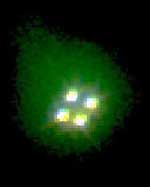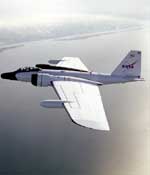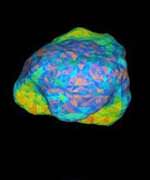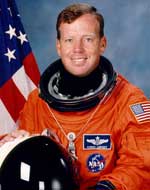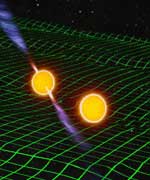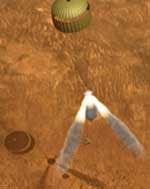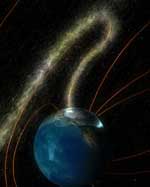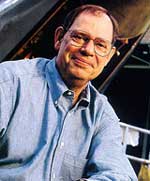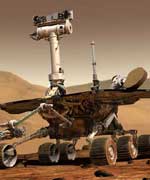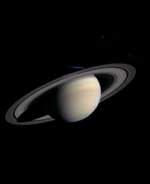
Image credit: NASA/JPL
NASA’s Cassini spacecraft is on final approach to Saturn, and so far, the view is just getting better and better. The Saturn-bound spacecraft captured this photograph of the Ringed Planet on November 9th at a distance of 114 million km. The smallest features visible are 668 kilometres across, so the resolution is going to get much better as it gets closer. Five of the planet’s many moons can also be seen in this photograph (they were digitally enhanced to be easier to see). Cassini will finally arrive at Saturn on July 1, 2004.
A cold, dusky Saturn looms in the distance in this striking, natural color view of the ringed planet and five of its icy satellites. This image was composed of exposures taken by Cassini’s narrow angle camera on November 9, 2003 at 08:54 UTC (spacecraft event time) from a distance of 111.4 million km (69.2 million mi) — about three-fourths the distance of the Earth from the Sun — and 235 days from insertion into Saturn orbit. The smallest features visible here are about 668 km (415 mi) across, which is a marked improvement over the last Cassini Saturn image released on November 1, 2002. New features such as intricate cloud patterns and small moons near the rings should become visible over the next several months as the spacecraft speeds toward its destination.
Some details within Saturn’s massive ring system are already visible. Structure is evident in the B ring, the middle and brightest of Saturn’s three main rings. The 4800 km (2980 mi)-wide Cassini Division is the distinctive dark, central band that separates the outermost A ring from the brighter B ring. Interestingly, the outer edge of the B ring is maintained by a strong gravitational resonance with the moon Mimas, also visible in this image (see below). The 325 km (200 mi)-wide Encke gap in the A ring, near the outer edge of the ring system, is also visible, as is the fainter C ring, interior to the B ring.
With a thickness of only a few tens of meters or less, the main rings span 274,000 km (171,000 mi) from one end to the other? about three-quarters of the distance between the Earth and the Moon.
Saturn’s multi-banded, multi-hued atmosphere is also apparent at this distance. In this composite made of images taken through broadband blue, green, and red spectral filters, the color is very close to what the human eye would see. The different hues of yellow, brown and red seen in the illuminated southern hemisphere are more delicate and subtle than the colors on Jupiter. Coloration on both Jupiter and Saturn is caused by small colored particles mixed with the white ammonia clouds. The ammonia clouds on Saturn are deeper and thicker than those on Jupiter because ammonia gas condenses at a deeper level in Saturn’s colder atmosphere. The composition of the colored particles is not known but is thought to include sulfur and nitrogen as key constituents at middle and low latitudes.
In the southern polar region, a dusky haze is visible, more gray than the light-brown at middle latitudes. This polar haze may be produced by energetic electrons and protons in the aurorae which destroy methane gas, leading to the formation of a haze of complex hydrocarbons.
Most of Saturn’s northern hemisphere is in shadow of the rings, with the exception of a small sliver visible on the limb. (Light passing through the Cassini Division illuminates the higher altitudes in the atmosphere.) This sliver appears bluer than the visible southern hemisphere, probably due to molecular scattering by hydrogen at these altitudes above the haze and clouds. As the Cassini tour unfolds over the next five years and beyond, we will have an opportunity to see how the colors change with time, whether due to changing seasonal heating or to some other mechanism.
Five Saturnian satellites can also be seen in this image. The brightnesses of these bodies have been increased three- to ten-fold to enhance visibility. The satellites are, on the left, from brightest to faintest, Rhea (1530 km, 951 mi across), Dione (1120 km, 696 mi), and Enceladus (520 km, 323 mi); and on the right, from brightest to faintest, Tethys (1060 km, 659 mi) and Mimas (392 km, 244 mi).
From the Voyager encounters in 1980 and 1981, we know that each of Saturn’s icy moons possesses intriguing features. Enceladus is the most reflective body in the solar system; both Mimas and Tethys exhibit large craters on their surfaces; Dione and Rhea have curious streaks of bright, wispy material. Cassini will make very close approaches to Rhea, Dione and Enceladus, returning images in which features as small as 50 meters or less will be detectable. Images with details finer than those seen by Voyager (~ 2 km, 1.3 mi) will be returned from all five moons.
Cassini will enter Saturn orbit on July 1, 2004.
The Cassini-Huygens mission is a cooperative mission of NASA, the European Space Agency and the Italian Space Agency. JPL, a division of the California Institute of Technology in Pasadena, manages the mission for NASA’s Office of Space Science, Washington, D.C.
Original Source: NASA/JPL News Release

